| Published
on 20
May 2009 |
All rights reserved.
|
|
|

|
New BMW roadster tries to be more SLK
than Boxster...
|
BMW
maybe renowned for producing sports saloons, but until now it has yet
to master the know-how of sports cars. No matter Z1, Z3 or Z4, none
came close to the level of Mazda MX-5 or Porsche Boxster. The outgoing
Z4 especially attracted a lot of criticisms – weird looks, lifeless
steering, harsh ride from run-flat tires and a chassis favouring
understeer. If it were Audi, it would have sorted these problems one by
one in the next generations until perfect. However, this is BMW, a
company rarely responds to criticisms and always keeps doing what it
thinks right. It refused to admit defeat, so it simply changed the
nature of Z4, turning it into a luxury-biased coupe-cabriolet like
Mercedes SLK. Can it save the game ?
The second generation Z4, codenamed E89, looks so familiar. There are
detailed changes to its design, of course, but its roots cannot be more
obvious. Like the old car, its proportion is so wrong, with a long long
bonnet and a tiny tail. The small passenger compartment locates just in
front of the rear axle, more like a 1936 Morgan than a modern sports
car. The weird “Flame-surface” design theme continue to distort the
body surfaces, creating tensions in the same way as a heavily bruised
sardine tin. Chris Bangle or Adrian van Hooydonk makes no difference to
the fate of this car.
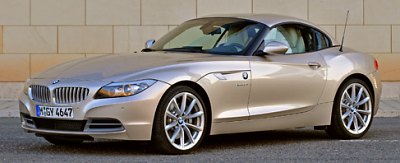
|
“Flame-surface” design is about as
stylish as a bruised sardine tin...
|
Like
the exterior, the chassis is an evolution of the outgoing car. Its
basic format of FR, MacPheson strut and multi-link suspensions and
electrical power steering remain intact. Though being 148 mm longer,
its wheelbase is virtually unchanged at 2496 mm, while the body is only
9 mm wider. Electronics-wise, it gets adaptive damping (if you opt for
“Adaptive M Sport” suspension) and a switchable control system called
“Dynamic Drive Control”, which offers 3 modes (Sport, Normal and
Comfort) to alter damping stiffness, throttle response, steering
effort, stability control threshold and transmission mapping.
However, the biggest change lies on the roof. In an attempt to lift
showroom appeal, the BMW roadster follows Mercedes SLK to adopt a
retractable metal roof, made of 2 aluminum panels and associated
electrohydraulic mechanism. Press a button and the roof will rise from
the boot in only 20 seconds. Now the Z4 provides all the noise
insulation and chassis stiffness of a coupe, effectively eliminating
the need to build Z4 Coupe, which was unfortunately the most lovely
version in the past.
Nevertheless, the retractable roof has its problems, too. When being
stored, it eats 130 liters of luggage space, leaving only 180 liters.
But even more problematic is the additional weight it brings, which
lifts the car some 100 kilograms above its equivalent predecessor. You
know, more weight leads to slower performance and poorer handling. We
shall review its dynamic aspect later on.

|
Retractable roof kills the lovely Z4
Coupe...
|
Apart
from the roof, the cabin is another area of vast improvement. While the
basic architecture and the snug feel remain, the redesigned dashboard
and console, taking inspiration from the late Z9 (nearly forget that
car), looks more stylish. Materials are more expensive. New i-Drive
becomes much more intuitive. As before, you sit low in the cockpit,
near the rear axle and view forward across the long bonnet.
Annoyingly, BMW names the versions of new Z4 as sDrive23i, sDrive30i
and sDrive35i, in which "sDrive" represents rear-wheel drive (versus
"xDrive" for 4WD) and the number refers to its confusing engine
performance index. The sDrive23i is powered by the existing 2.5-liter
Valvetronic magnesium crankcase straight-6 with 204 horsepower.
Performance is 148 mph top speed and 0-60 mph takes 6.3 seconds with
6-speed manual gearbox. Alternatively you can opt for a 6-speed
Steptronic automatic.
sDrive30i employs the 3.0-liter version of the Valvetronic magnesium
crankcase straight-6. Confusingly, its output drops back to 258
horsepower from the previous 265 hp. It will top a regulated 155 mph
and sprint from 0-60 mph in 5.6 seconds, which is slower than the old
car due to the extra weight. Transmissions are the same as the base
engine.
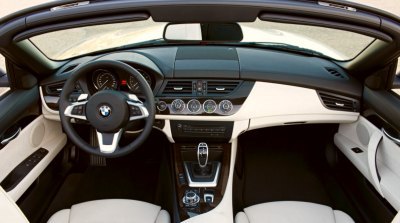
|
Dashboard and console takes
inspiration from the late Z9...
|
sDrive35i
is the new range topper. It uses the now familiar twin-turbo 3.0-liter
direct-injection straight-6 with 306 horsepower and 295 lb-ft of
torque. Mate with manual box it delivers 0-60 mph in 5.1 seconds and 30
mpg combined consumption. Like M3 and 335i coupe, it offers the new
7-speed DCT double-clutch gearbox as option, which reduces 0-60 mph by
0.1 second. All six-cylinder engines are now part of the “Efficient
Dynamics” package, which include brake energy regeneration, on-demand
coolant / oil pumps, electrical power steering and low rolling
resistance tires to reduce fuel consumption and emission.
On the Road
The change of personality is instantly obvious on road. For the first
time ever, the Z4 rides supplely on anything but the roughest. Its
damping over primary ripples is especially improved, making it much
less painful to travel on country roads. The stiffer chassis does not
shake or squeak under cornering load, adding to the refined feel. If
you opt for the DCT double-clutch gearbox, you will be amazed by its
seamless gearshift, too.
You can’t argue that BMW has the best six-cylinder engines in the world
– smooth, refined and willing. They help making the new Z4 a good
companion for motorway cruising.
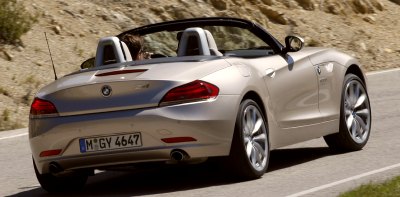 |
A 3-Series saloon is probably more fun
to drive...
|
However,
when the road get twistier, you will find its chassis has lost the
honesty of the old car. Its extra weight and refinement seem to add a
thin layer of isolation between the man and machine. For example, prod
the throttle, the engine does not respond as quickly as you would
expect in a lightweight roadster. Push it into corner, it rolls more
than a sports car should, while its nose runs wide more easily than you
expect - understeer is still the family name of Z4. The electrical
power steering is once again too slow (2.7 turns from lock to lock) and
too numb. The long distance between the driver and the front wheels
adds to the sense of isolation.
In fact, a 3-Series saloon is probably more fun to drive than the Z4,
which hurts.
BMW has confirmed that there won’t be a M version to follow. It argued
that a Z4 sDrive35i with DCT transmission and Adaptive M suspension is
already capable enough to replace the old Z4 M. Price-wise, the
£40,000 combination really leaves no space for the M car.
Fun-wise, however, it will never fulfill that vacancy.
|
Verdict:    |
| Published
on 10
Mar
2010 |
All rights reserved.
|
|
Z4 sDrive35is
|
|
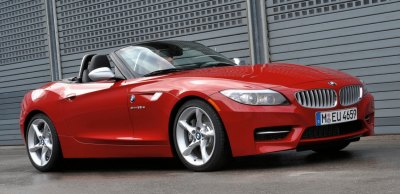
|
With more power and sharper suspension
tuning, is this finally the BMW sports car we have been expecting ?
|
We had a lot of complaints
on the second generation Z4: 1) Its styling suits only acquired taste;
2) It
got heavier due to the bulky roof mechanism, dampening performance; 3)
Its chassis dynamics became civilized, losing the raw excitement of the
original car. The first problem is not going to be solved until the
next generation is introduced, but the second and third problem may be
addressed by the new range topper, sDrive35is.
As implied by its name, sDrive35is is not a big departure from the
existing sDrive35i. Its heart is still that N54 twin-turbo 3.0-liter
straight-six, but higher turbo boost lifts its output to 340hp and 332
lb-ft, compared with the original 306hp and 295 lb-ft. Moreover, it
enables a momentary overboost to 369 lb-ft. All these are done without
altering the internals of the engine, proving how tunable the N54 is.
To improve performance further, 7-speed twin-clutch DCT gearbox comes
standard on the sDrive35is. This combination results in a much more
satisfying performance, i.e. 0-60 mph takes only 4.7 seconds, although
top speed is regulated at 155 mph as usual. This car is every bit as
fast as the outgoing Z4 M Roadster, though its power delivery and sound
are no where as exciting. Like the regular N54, its power delivery is
smooth and free of turbo lag. You get maximum thrust from just 1500
rpm, and maximum power is reached at 5900 rpm, so it never tempts you
to access the upper end of rev range. The DCT box is also less engaging
to use than the M-car's 6-speed manual. However, compare with lesser
Z4s its performance edge is still a welcomed improvement.
The sDrive35is gets a slightly more aggressive aero kits (which will be
offered to lesser models as option) and adaptive M sport suspensions.
The latter includes stiffer springs and adaptive dampers, thicker
anti-roll bars, 18-inch low profile tires and 10 mm lower ride height.
These changes successfully sharpens its handling, bringing tighter body
control and sharper turn-in without damaging ride quality much. It is a
well-judged compromise. The handling becomes more neutral. With
stability control disabled you can access to a progressive power slide.
Nevertheless, the sDrive35is is hard to recommend because its price
matches that of Porsche Boxster S. Yes, it has a decisive performance
edge over the Porsche, but it is no where as engaging to drive, let
alone looks. |
Verdict:    |
| Published
on 14
Oct
2011 |
All rights reserved.
|
|
Z4 sDrive28i with N20 engine
|
|
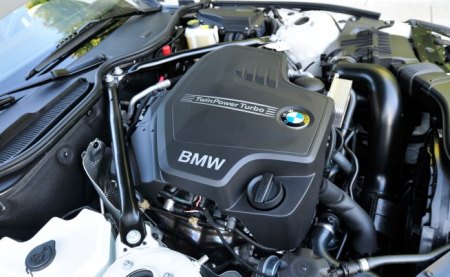
For decades, BMW's
straight-sixes have been one of the best engines in the automotive
world. However, under the pressure for reducing emission and
consumption, its days are numbered. From now on, the naturally
aspirated version of the straight-six, no matter in 2.5-liter or
3-liter form, will be replaced with a 2-liter turbocharged
four-cylinder engine codenamed "N20". This will begin from the Z4, then
5-series, 3-series and eventually all other models. Only the
turbocharged version of the straight-six (on the "35" models) will
escape from the axe, because it is being used as a downsized
substitution to V8.
On paper, the N20 loses little to the straight-six. Thanks to the
incorporation of Double-Vanos, Valvetronic, direct injection and a
twin-scroll turbocharger, it produces a respectable 245 horsepower,
trailing the standard tuned 3-liter straight-six by only 13 horses. On
the other hand, its torque delivery overwhelms the latter, with 258
lbft delivered from just 1250 rpm against 221 lbft at 2600 rpm. This
mean in the real world the smaller engine actually feels punchier than
the old one. Moreover, the loss of two cylinders and the inclusion of
automatic stop-start achieve 20 percent lower fuel consumption, raising
the mpg figure of Z4 from 33.2 to 41.5 mpg. The corresponding carbon
emission is lowered from 199 to 159 grams per km.

However, is it really by all means better than the traditional
straight-six? Of course not. While it is certainly more efficient, it
is not as inspiring to drive. No matter how great an inline-four engine
is tuned, it still fails to produce a melodious symphony that the old
straight-six plays. The same goes for smoothness and the eagerness to
rev. Although it is said to be redlined at 7000 rpm, it is reluctant to
do so. As the output peaks at only 5000 rpm, higher rev brings little
reward but more protest in noise and refinement. In other words, it
does not encourage you to use more of it. A more laid-back style is
preferred. Doesn't it sound very un-BMW?
Theoretically, the four-banger's 10 kg lighter weight and shorter
length could improve weight distribution thus handling. In the real
world, however, no obvious change can be felt on the Z4 sDrive28i. This
is still a dull car to drive. The switch to N20 engine only continues
BMW's trend of going ordinary. In fact, from the recent 5-series and
1-series we can also see BMW is losing focus on driving fun. Perhaps
it's time to stop and rethink whether emission is top priority to the
brand.
|
Verdict:    |
|